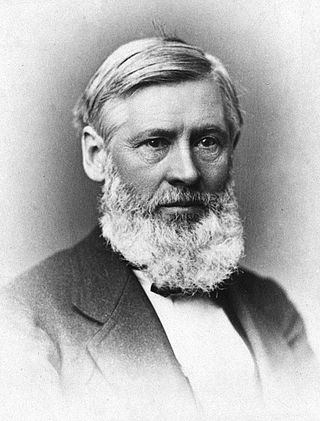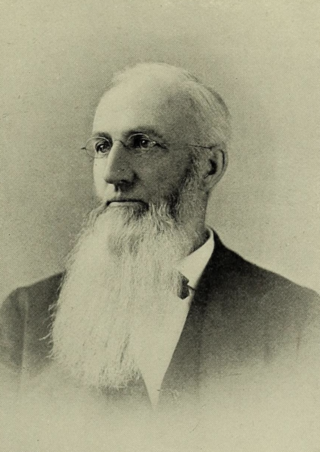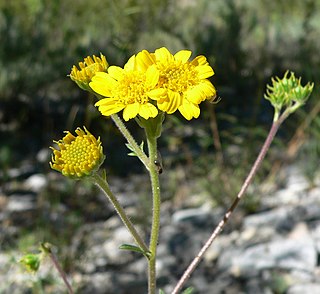
Asa Gray is considered the most important American botanist of the 19th century. His Darwiniana was considered an important explanation of how religion and science were not necessarily mutually exclusive. Gray was adamant that a genetic connection must exist between all members of a species. He was also strongly opposed to the ideas of hybridization within one generation and special creation in the sense of its not allowing for evolution. He was a strong supporter of Darwin, although Gray's theistic evolution was guided by a Creator.
Harold Ernest Robinson was an American botanist and entomologist.

Charles Wright was an American botanist.

Houstonia caerulea, commonly known as azure bluet, Quaker ladies, or bluets, is a perennial species in the family Rubiaceae. It is native to eastern Canada and the eastern United States. It is found in a variety of habitats such as cliffs, alpine zones, forests, meadows and shores of rivers or lakes.

Sereno Watson was an American botanist. Watson was born on December 1, 1826, in East Windsor Hill, Connecticut. Graduating from Yale in 1847 in Biology, he drifted through various occupations until, in California, he joined the Clarence King Expedition and eventually became its expedition botanist. Appointed by Asa Gray as assistant in the Gray Herbarium of Harvard University in 1873, he later became its curator, a position he maintained until his death. Watson was elected a Fellow of the American Academy of Arts and Sciences in 1874, and a member of the National Academy of Sciences in 1889. He died on March 9, 1892, in Cambridge, Massachusetts.

Houstonia (bluet) is a genus of plants in the family Rubiaceae. Many species were formerly classified, along with other genera since segregated elsewhere, in a more inclusive genus Hedyotis.

Ericameria laricifolia is a North American species of flowering shrub in the family Asteraceae known by the common name turpentine bush, or turpentine-brush. It is native to the southwestern United States and northern Mexico (Chihuahua).

Hymenothrix is a small genus of North American flowering plants in the daisy family known as thimbleheads. They are native to the southwestern United States and northern Mexico.

Houstonia longifolia, commonly known as long-leaved bluet or longleaf summer bluet, is a perennial plant in the family Rubiaceae. It can be found throughout most of the Eastern United States and Canada. It has been reported from every state east of the Mississippi River except Delaware, plus North Dakota, Minnesota, Missouri, Arkansas and Oklahoma, with isolated populations in Kansas and Texas. Also, all Canadian provinces from Quebec to Alberta. It prefers upland woods in poor, dry, often sandy soil.
Dichaetophora is a genus of flowering plants in the family Asteraceae.

Houstonia pusilla is a plant in the family Rubiaceae native to the United States and common in the southeastern and central parts of the country, from Texas to Florida north to Long Island and South Dakota, plus an isolated population in Pima County, Arizona.

Phaulothamnus is a genus of plants formerly included in the family Phytolaccaceae but now considered a part of the Achatocarpaceae.

Houstonia correllii, the Zapata County bluet, or Correll's bluet, is a species of plants in the Rubiaceae. It is known only from Zapata County in southern Texas. It is a prostrate, mat-forming plant with white flowers.
Houstonia acerosa, the New Mexico bluet or needleleaf bluet, is a plant species native to Chihuahua, Coahuila, Nuevo León, Tamaulipas, San Luis Potosí, Texas and New Mexico.
Houstonia palmeri, the Saltillo bluet, is a plant species in the family Rubiaceae, native to the Mexican states of Coahuila and Nuevo León.

Houstonia humifusa, commonly called matted bluet, is a plant species in the coffee family (Rubiaceae). It is native to the United States, where it is found in Texas, Oklahoma, and New Mexico. It is typically found in sandy areas, or sometimes over gypsum.

Houstonia wrightii, the pygmy bluet, is a plant species in the Rubiaceae. It is native to the south-western United States and northern Mexico.
Galium texense, the Texas bedstraw, is a species of plants in the coffee family. It is native to Texas, Oklahoma and Arkansas.
Beryl B. Simpson is a professor emerita in the Department of Integrative Biology at the University of Texas at Austin. Previously she was an associate curator at the Smithsonian National Museum of Natural History in the Department of Botany. She studies plant systematics and tropical botany, focusing on angiosperms found in the American Southwest, Mexico, and Central and South America. She was awarded the José Cuatrecasas Medal for Excellence in Tropical Botany for her decades of work on the subject.
Hypericum galioides, the bedstraw St. Johnswort, is a species of flowering plant in the St. John's wort family, Hypericaceae. It is endemic to the Southeastern United States.











